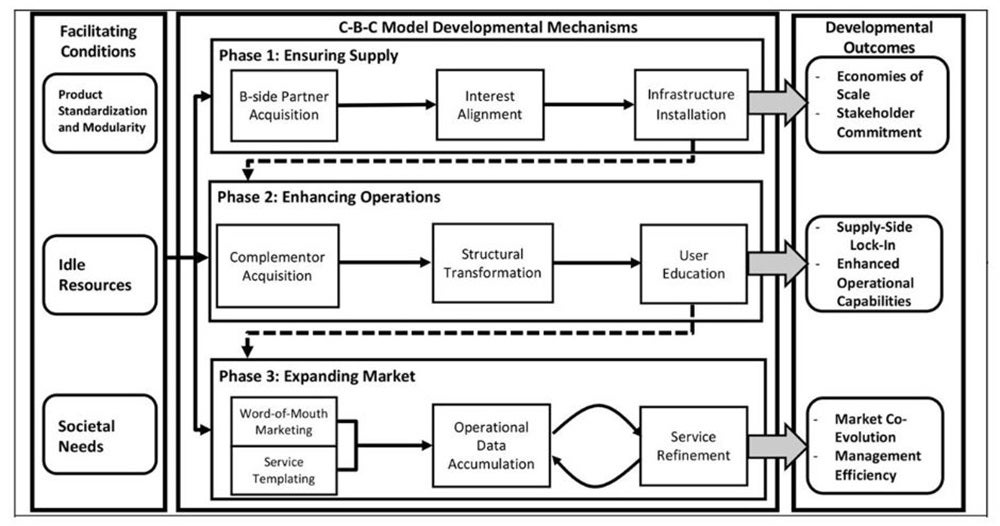Solving China's car parking crisis with Airparking’s C2B2C solution
New research explores how Airparking’s C2B2C platform addresses China's severe parking shortage through smart parking technologies and strategic partnerships
China has a big problem with carparking. There are about 440 million motor vehicles (345 million of which are automobiles) on roads in China as of June 2024, according to China's Ministry of Public Security. And by 2025, parking demand will reach 600 million spots, however, research from Intertraffic China estimates that only 250 million parking spaces exist. The number of cars in China has skyrocketed in recent years, outpacing the construction of parking facilities. This shortage contributes to severe traffic congestion in many Chinese cities, and as a result, there’s a growing focus on smart parking technologies to optimise the use of existing spaces and reduce congestion.
One company in China has employed a unique business model to help alleviate pressure on parking capacity for motorists seeking parking across China. Established in 2015, Airparking has grown quickly to become one of the most successful online parking space-sharing platforms in China. Airparking is based in Guangzhou, which, like many of China’s cities and megacities, is facing a dramatic shortage of parking spaces.
In 2023, it is estimated that Airparking managed more than 2000 contracted projects with over 500,000 parking spaces and 2 million-plus users on its platform. It is currently operating in 14 cities, including Guangzhou, Qingdao, Wuhan, Changsha, and Taiyuan. Airparking has broken even and has been a profitable enterprise since 2019 – thanks largely to a variety of creative developmental mechanisms in the development of its unique platform.
Airparking relies on users sharing their parking space on its platform, by connecting the owners of parking spaces with drivers seeking them via an online parking service platform. This platform relies on a consumer-to-business-to-consumer (C2B2C) model, which uses technological advances in real-time data capture, processing, and analysis, such as internet of things (IoT) devices, omnipresent communications, and cloud computing, to integrate data on idle parking spaces and provide an online parking service platform aimed at alleviating the parking problems of busy cities by connecting the owners of parking spaces and those seeking them.

Airparking’s consumer-to-business-to-consumer (C2B2C) model
While consumer-to-consumer (C2C) platforms are a well-established and studied aspects of the increasingly prominent sharing economy, new research into the C2B2C economy sheds light on this unique model and the importance of strategic partnerships, stakeholder alignment and continuous service refinement to its success.
The research paper, The development of a C2B2C sharing economy platform: A case study of China’s Airparking, seeks to address the knowledge gap around this emerging model through a case study of a successful C2B2C enterprise. According to paper co-author Professor Barney Tan, Head of School and a Professor at the School of Information Systems and Technology Management (ISTM) at UNSW Business School, the catalyst for the research was the growing prominence of the sharing economy and the academics’ interest in the new platform-based models to which it had given rise.
“While much attention has been given to consumer-to-consumer (C2C) platforms like Airbnb and Uber, the emerging consumer-to-business-to-consumer (C2B2C) model intrigued us due to its unique intermediary structure and potential benefits,” said Prof. Tan, who co-wrote the paper with Weihang Huang, a Research Assistant at the University of Sydney Business School; Evelyn Ng, a Lecturer in Business Information Systems at the University of Sydney Business School; and Chunmian Ge, a Professor in the Department of Financial Management, School of Business Administration at South China University of Technology.
Noting a lack of scholarship around these novel platforms, the researchers undertook a case study of Airparking, with a view to better understanding the processes behind its parking space-sharing platform and how these have contributed to its development as a successful C2B2C enterprise.

A new sharing economy model
The research paper explained that Airparking’s C2B2C platform is successful because it collaborates closely with business-side partners, property management companies that manage parking lots on behalf of the property (asset) owners. After the contracts are signed with the property management companies, Airparking takes charge of infrastructure installation and structural transformation for parking lots and enables their operational capabilities through the implementation of Airparking's parking management system to deliver the service of parking space sharing.
Asset owners can register parking spaces located in the enabled parking lots, while drivers can also reserve parking spaces and complete the transactions on the user app. The managers in the property management companies can use the property management app to track and analyse day-to-day operations and capacity utilisation. Drivers on the platform can also access services such as pre-booking, rapid positioning, and intelligent matching, as well as setting up various payment options (e.g., a park first, pay later scheme) via the Airparking app.
The research paper detailed how Airparking’s C2B2C model has emerged from the C2C model with unique characteristics and business benefits that warrant more attention. This model introduces an intermediary business organisation that facilitates transactions between the two consumer sides. “On the surface, the B-side of a C2B2C business model shares some similarities with traditional business intermediaries: they both facilitate the efficient allocation of goods or services between providers and customers through capturing, aggregating and exploiting information about participating parties,” the paper explained.
Read more: Digital disruption: how can traditional businesses thrive?
“The difference, however, is that B-side entities do not participate in the process of value creation directly. Instead, they play a complementary role in making the process of matching providers to consumers more efficient or effective, and they are typically rewarded not by entities downstream along the value chain but by the platform itself.”
The researchers found that C2B2Cs share the strengths of the C2C model while mitigating some of its weaknesses. As such, Prof. Tan called the development of this model a “significant evolution in peer-to-peer business models”. For example, C2C platforms generally work with private providers and consumers rather than businesses, and the heterogeneity of these entities can limit scalability and profits. In contrast, C2B2Cs take greater advantage of the asset-light nature of the sharing economy.
“Unlike traditional C2C models, the C2B2C model mitigates these challenges by incorporating a B-side entity responsible for managing and maintaining assets or services,” Prof. Tan said. “This intermediary role allows for better resource management, higher service quality and the unlocking of economies of scale, addressing supply challenges more effectively.”

The development, iteration and refinement of a C2B2C model
The research indicated that a process of at least three phases is at work in the development of a C2B2C platform, with each phase – ensuring supply, enhancing operations and expanding market, respectively – composed of distinct steps that can lead to different outcomes.
The researchers also identified three facilitating environmental conditions that were conducive to all phases of the process: product standardisation and modularity, the presence of idle resources, and the existence of societal needs. “These conditions help in scaling the operations of the C2B2C platforms efficiently and meeting market demands effectively,” Prof. Tan explained.
The paper explained that, because most parking spaces in China were privately owned when Airparking was established, making negotiations with individual parking space owners unfeasible, the company first needed to identify a critical mass of B-side management companies to work. It also required long-term contracts and exclusive cooperation, given that Airparking’s business model is incompatible with the presence of other systems.
Interest alignment among stakeholders was also necessary to circumvent potential resistance to Airparking’s new processes, both to encourage buy-in and to account for and protect stakeholders’ interests and welfare. This first phase enabled the achievement of economies of scale and stakeholder commitment.
Read more: The bullseye framework: a perfect business model canvas teammate
In the second phase, Airparking enhanced its operations as its business grew, including acquiring complementors, or companies that provided related products or services to mutual customers, which increased the value of both offerings. It also engaged in structural transformation of its business model, operations and customer experience. The outcomes of this enhancing operations phase were the achievement of supply-side lock-in and enhanced operational capabilities.
Finally, in the expanding market phase, Airparking relied on word-of-mouth marketing and engagement of stakeholders to promote its services. Service templating allowed it to deliver a consistent service experience through a standardised platform, and data accumulation allowed it to refine its operations continuously. Airparking was thereby able to achieve market co-evolution, adapting its offerings to customers’ changing demands over time.
“By enhancing operational capabilities and iteratively refining services based on operational data, platforms can achieve market co-evolution, where they adapt their offerings to meet changing customer needs over time,” according to Prof. Tan.

Implications for business and beyond
The research demonstrates the C2B2C model’s transformative potential within the sharing economy, Prof. Tan said, with relevance in both business and academic contexts and valuable lessons about the importance of structured development phases. “Businesses can adopt similar strategies to ensure supply and enhance operations through technological integration and stakeholder alignment. Academically, the findings can inform curriculum development and research on digital platform management and innovation, emphasising practical insights from successful case studies,” he said.
He also identified several avenues that future research might explore based on the Airparking study, such as comparative studies examining other C2B2C platforms and longitudinal studies tracking the evolution and impact of this model. Future research could also investigate the policy and regulatory implications of C2B2C platforms for policymakers.
Subscribe to BusinessThink for the latest research, analysis and insights from UNSW Business School
“By bridging the gap between individual providers and consumers through a professional intermediary, these platforms can offer more reliable and scalable services,” Prof. Tan said. “The insights from our study highlight the importance of strategic partnerships, stakeholder alignment and continuous service refinement.”
Better understanding these dynamics will allow businesses – and researchers – to benefit from “more innovative and sustainable platform-based business models that cater to the evolving needs of modern economies”, he concluded.
